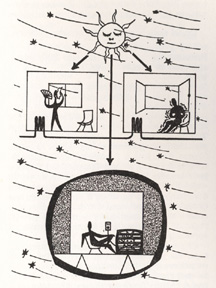
lowering the biocost of everyday life

biocost and user experience metrics
I.
flickr was better than its predecessors because 'it made tagging easy'.
phrased differently, flickr 'lowered the biocost of tagging'—the time and effort it took to add tags. a particular technology (now called AJAX) helped get there, but the experience was clearly understood as 'better' because flickr was easy to learn and fast to use. ("Yahoo's Eckart Walther says that the principal reason Yahoo bought Flickr was to acquire its tagging technology and expertise.")
biocost is the human cost to achieve a goal. not the moneycost, but the biocost:
the time it takes—in minutes, hours, or days
the attention it requires—for example, what other things you can do at the same time
and also,
the stress it brings—because it's hard to learn or you're in a rush
II.
we can measure the relative advantages of one UI over another in terms of 'biocost'. by doing so, we shift the 'merit' of one portal experience over another from 'media company vs. technology company' to 'services company vs. services company'—that is, the two experiences are commensurable. now we may assign merit to the most productive, humanly-useful experience, and see beyond brands and habits.
III.
we want our software to do what we want transparently—without our thinking about it. Put another way, we want to 'lower the biocost of using software'.
what takes biocost at a user interface?
learning how to use it
using it—telling it what you want to do. in today's interfaces, this means telling it step-by-step, mouse-click by mouse-roll and keypress
the portal that develops the means to lower the biocost of web-delivered services will attract the most users for a given service segment. the portal that develops the most general means to lower biocost will attract the most users.
users will pay for services that lower the biocost of getting what they want. the money is in the biocost.
IV.
humans are goal-driven systems—we take actions always in the context of goals. these goals may be short-term or long-term, changeable or relatively constant, predictable or un-predictable, specific or vague.
searching, learning, understanding, and deciding are all types of goals.
there will be significant advantages to the user interface that is explicitly supportive of a user's formulation, evolution, representation, sharing, and carrying-out of goals.
a goal-driven user experience will significantly lower the expenditure of biocost of users for getting what they want.
Q.E.D.
Cybernetic Lifestyles — Experimental Pages (c) CJ Maupin & Paul Pangaro 2005-2007. All Rights Reserved.